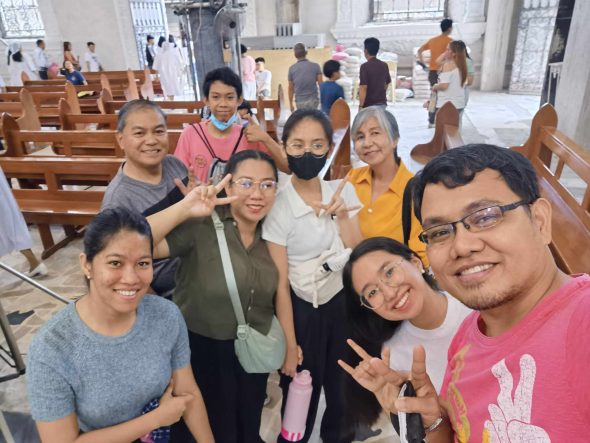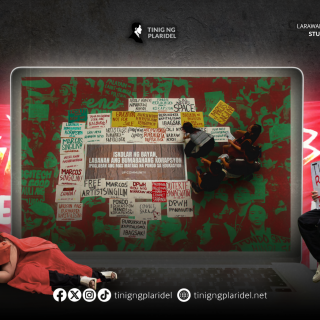
After a grueling day in school, then-high school student Allena Juguilon was eating dinner at home in Angeles City, Pampanga, when she heard loud rattling noises coming from their front gate.
The knocks came from two men who had just got off from a tricycle. A family member went out to check why there were unknown men outside their home during nighttime.
“Nasaan po dito ‘yung batang nagi-interpret sa simbahan?,” one of the men asked loudly.
Allena’s heart pounded with nervousness—she is that girl who does sign language interpretation every Sunday mass. She was who the men were exactly looking for.
When asked why they were looking for Allena, the men explained that they needed her help.
She dropped everything she was doing and went to a house where a young deaf couple was arguing. The lovers communicated through signs and gestures while their families, unfamiliar with it, could only watch.
Upon arriving, she filled the space between the fighting lovers and facilitated the communication between them and their families.
“Imagine, in our community pa lang ‘to. Paano pa sa ibang community? Paano kung wala silang kakilalang Deaf [or sign language interpreter], maaayos kaya ‘yung mga gantong bagay?,” Allena shared after recalling her experience from years ago.
Lending a hand
Since 2012, Allena, 22, has been one of the sign language interpreters serving at the Holy Rosary Parish Church in Angeles City, Pampanga.
She first encountered sign language in fifth grade while studying in a public elementary school. Her interest with signing sparked as she watched her teachers use the visual language to help learners with disabilities participate in school activities.
So, when her teachers asked for volunteer sign language interpreters in their school, Allena did not hesitate to heed the call. Together with other students, Allena learned to understand and interpret American Sign Language (ASL) under the guidance of her grade school teacher.
ASL is a form of sign language widely used in North America, brought by American teachers in the Philippines during the 1900s. Later on, they needed to learn a new sign language—the Filipino Sign Language (FSL)—to communicate better with the Filipino Deaf community.
FSL was declared as the national language of the Filipino Deaf and the official sign language of the government through the Republic Act 11106 or “The Filipino Sign Language Act,” which was signed into law by former president Rodrigo Duterte in 2018. The law also mandates the use of FSL in schools, broadcast media, and workplaces.
Allena’s teacher eventually encouraged the trained pupils to make good use of their skills by volunteering as sign language interpreters at the Holy Rosary Parish Church every Sunday. This marked the beginning of her service in the church, interpreting sign language during liturgical celebrations and activities.
“Usually, nagre-review kami ng Sambuhay (missalettes) kahit the night before lang or a few hours before the Mass. Para alam namin ‘yung mga terms or mga context ng story… para mas ma-sign namin in a better way and mas maintindihan ng mga Deaf ‘yung misa,” Allena said.

She and her fellow sign language interpreters would stand in front of the altar of the Holy Rosary Parish Church to assist Deaf churchgoers, who occupy two pews or more.
Sometimes, Mass attendees film Allena while she interprets, and would later reach out to her and explain that their purpose was to show their Deaf relatives or friends that their church has sign language interpreters.
However, as the COVID-19 pandemic struck, the Holy Rosary Parish Church needed to switch to social media livestreams and live telecasts to continue holding liturgical celebrations.
The sign language interpreters then, including Allena, had to convey signs while facing a camera.

Amid difficult circumstances, Allena believed she reached more of the Filipino Deaf community through technology.
Silent struggles
Despite years of service in the Holy Rosary Parish Church, Allena revealed that sign language interpreters have yet to be officially recognized by their church as a ministry and part of their community.
While the parish leadership has been accepting of the Deaf community, the church only designated a space for them after the pandemic.
Prior to this, Allena and her fellow sign language interpreters would still need to arrive early to reserve seats for the Deaf churchgoers so they may see the interpreters and the Mass clearly. This is due to space constraints amid the ongoing restoration of the heritage church after a 6.1-magnitude earthquake damaged its structure in 2019.
According to Allena, there were times before that they were confronted and scolded by “inconsiderate” churchgoers for reserving the front seats for the Deaf Mass attendees.
“Ang hirap na pati sa loob ng simbahan [ay] pinaglalaban ‘yung karapatan nila [Deaf community] na makapag-join ng misa…. Hindi sila kumakanta pero nagsa-sign language sila. Pero kasi, hirap din silang magawa ‘yun kung sila mismo hindi nila naiintindihan kung ano nangyayari dahil nga hindi na makita or malayo sila sa altar,” she lamented.
While they have been an integral part of the local parish, Allena shared that there has also been a decrease in sign language interpreters serving in church activities over the years. As of this writing, only Allena and her grade school teacher are taking shifts in interpreting for the Deaf churchgoers.
This challenge is not only experienced by the Holy Rosary Parish Church, but by the whole country.
There are 1,784,690 Filipinos with hearing difficulties as of 2020, according to the Philippines Statistics Authority.
However, there were only around 1,000 sign language interpreters registered with the Philippine Registry of Interpreters of the Deaf (PRID) in 2021. In Pampanga, there was only one registered sign language interpreter included in the directory of sign language interpreters and organizations released by the National Council on Disability Affairs (NCDA) in 2019.
Allena, now a junior communication research student at the University of the Philippines Diliman, admitted that she found it difficult to serve amid her busy schedule as she is now staying in Quezon City for her studies. Despite this, she always tries to return to Angeles City for the weekend to assist the Deaf community.
Through service, Allena found not only her purpose, but also valued friends and an embracing community.
“Bukod sa meron akong mga kaibigan at community na nafi-feel ko na belong ako, isang pinakagusto ko ring bagay is napaglilingkuran ko sila… Lalo ko rin naramdaman ‘yung meaning and purpose ko sa buhay kapag naglilingkod ako sa kanila through sign language, kahit sa misa lang,” she shared.

Allena saw her Deaf brothers and sisters in Christ like a family who understood and looked after her, even though her world was different from theirs.
Some people were surprised that Allena was not deaf. While she took no offense with the assumption, she wishes that more people would know that it is not only Deaf people who use sign language.
This inspired her to establish Angel Hands Deaf Catholic Community, an organization in Holy Rosary Parish Church to invite volunteer interpreters, gather support and official recognition for the Deaf, and ensure the longevity of their initiative. As of press time, the group is applying to be officially recognized in their church.
She also plans to learn more about sign language interpreting and be registered with PRID after she graduates from college and has enough resources for the training costs.
Allena hopes that more Filipinos would be willing to pursue learning sign language to communicate and understand those affected by hearing loss.
“Kung gusto niyo matuto, start siguro natin sa pagiging aware muna ng situation ng Filipino Deaf community. Kasi feel ko dun mo din makukuha ‘yung motivation na ipagpatuloy siya [kasi] sobrang laking pangangailangan din siya,” she said. “Sana unahin muna nilang kilalanin ‘yung danas ng Filipino Deaf community… para ma-feel din ‘yung halaga ng papasukin at hirap ng papasukin nila.”
But for now, Allena is one in amplifying the need for more inclusive spaces for the Filipino Deaf community. She does this by sharing God’s word, one sign at a time.
EDITOR’S NOTE: An earlier version of this story was submitted as a final requirement to the Journalism 111 (Feature writing) class under Asst. Prof. Adelle Chua.









